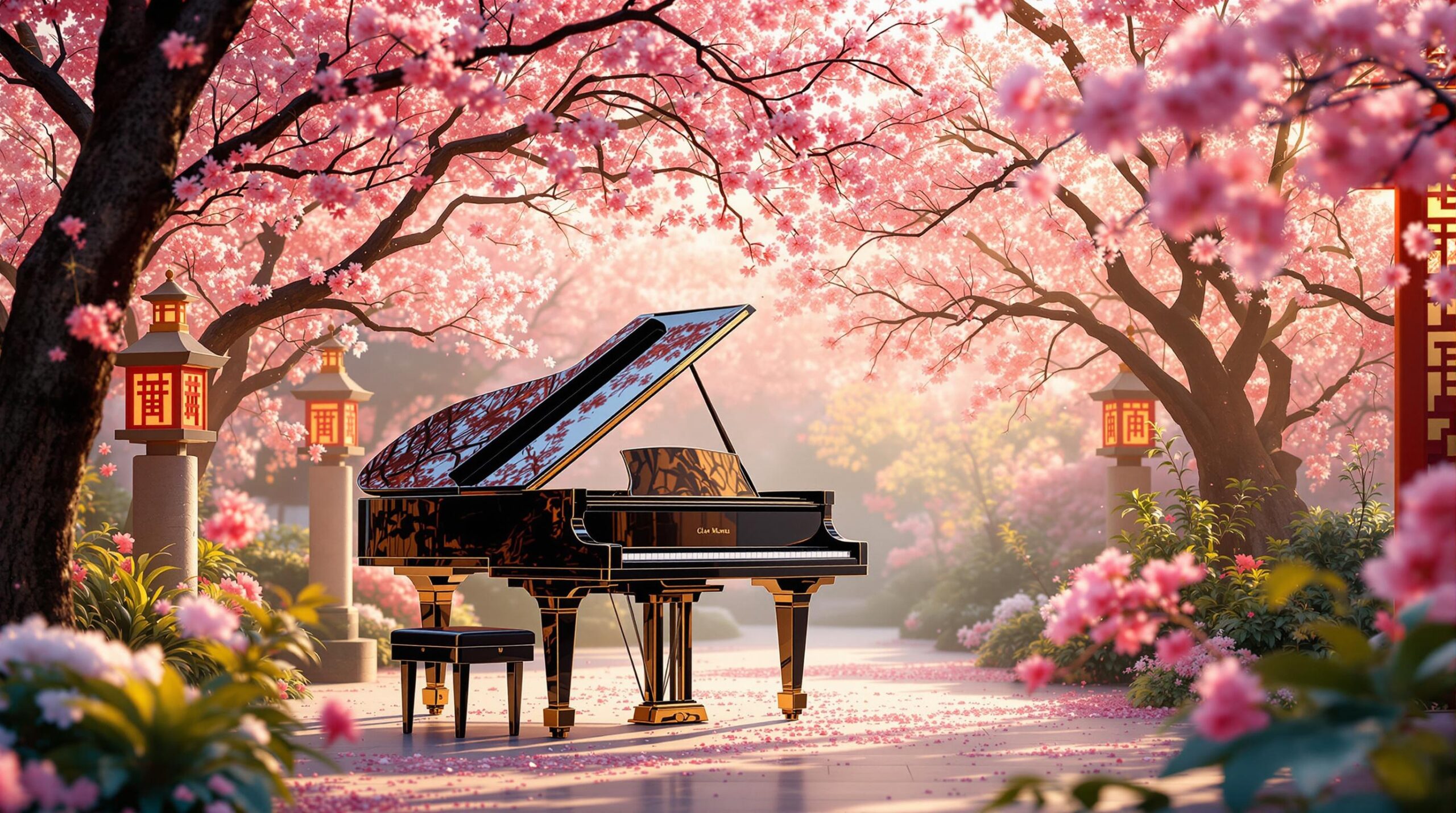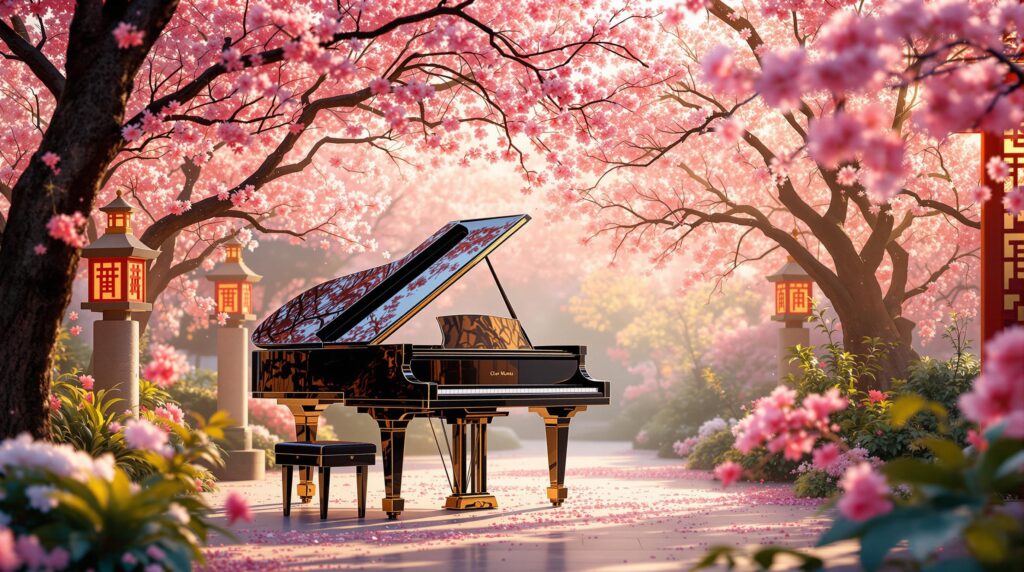
Chinese music has influenced global piano compositions by blending its pentatonic scales, folk-inspired rhythms, and textures of traditional instruments with Western classical techniques. This fusion enriches piano music with expressive melodies and unique tonal qualities. Key highlights include:
- Pentatonic scales: Central to Chinese music, creating distinct melodies.
- Folk music elements: Flexible rhythms, modal shifts, and textural contrasts.
- Modern composers: Innovating piano works that merge Eastern and Western traditions.
- Performance techniques: Mimicking instruments like the guzheng and erhu.
Today, Chinese-inspired piano pieces are performed globally, supported by music organizations that promote these works through education, events, and instrument accessibility. This ongoing exchange bridges cultures and expands the piano repertoire.
Colourful Clouds Chasing The Moon by Wang Jian-Zhong …
Elements of Chinese Music
This section dives into the key aspects of Chinese musical tradition, highlighting how its unique characteristics have influenced piano compositions.
Chinese musical traditions have brought a distinct flavor to piano music, particularly through two standout features: the pentatonic scale and influences from traditional folk music. These elements give piano pieces a distinctly Eastern essence.
Pentatonic Scale System
One of the defining traits of Chinese music is the pentatonic scale – a five-note system featuring tones known as gong, shang, jue, zhi, and yu. This scale creates melodies that are unmistakably Chinese and serves as a flexible foundation for composers to craft expressive, resonant works.
Folk Music Elements
Beyond the pentatonic scale, Chinese folk music contributes additional depth to piano compositions. Key influences include:
- Rhythmic flexibility: Tempos that flow naturally, mimicking the rhythm of spoken language.
- Modal variations: Subtle shifts in scales that create intricate and expressive melodies.
- Textural contrasts: Alternating between delicate, sparse passages and sections with richer, denser textures.
These features illustrate how traditional Chinese musical techniques continue to shape and inspire piano compositions worldwide, blending heritage with modern creativity.
Leading Chinese Piano Composers
Modern composers are building on the rich heritage of the pentatonic scale and traditional folk influences, introducing fresh interpretations. By blending Chinese musical traditions with Western classical piano, they are creating works that connect different cultural worlds.
Modern Chinese Composers
These composers combine classical piano techniques with elements of Chinese music, using traditional tonal systems, folk melodies, and unique rhythmic patterns. Their work expands how the piano is used, turning it into a tool for telling stories that cross cultural lines. This approach shines through in their compositions, which reflect the merging of both musical traditions.
Key Piano Pieces
Some notable piano works have emerged from this blend of traditions. These pieces showcase how Chinese musical elements – like folk-inspired themes and inventive harmonies – can enrich classical piano music. They reveal how the piano can express the delicate nuances of Eastern music while maintaining the structural complexity of Western styles.
sbb-itb-b8bc1ab
East Meets West in Piano Music
This section delves into how Chinese and Western musical traditions come together in piano music, building on earlier discussions about Chinese musical elements and composers.
Blending these traditions enriches the piano repertoire by combining the structural depth of Western classical music with the tonal and expressive characteristics of Chinese musical heritage.
Blending Musical Techniques
Piano pieces that merge Chinese and Western styles often use creative techniques, drawing from pentatonic scales and folk elements previously mentioned. Performers can also mimic the sounds of traditional Chinese instruments.
Some key techniques include:
- Using pentatonic scales within Western chord progressions
- Exploring timbres that evoke traditional Chinese instruments
- Incorporating rhythmic patterns from both traditions
Notable Combined Works
Modern compositions successfully mix Chinese musical textures with Western frameworks. This blend challenges pianists to engage with both traditions, offering a chance to explore a shared musical language.
Chinese Music’s Global Reach
Chinese musical traditions are leaving a strong mark on piano repertoire, introducing distinctive compositional styles and performance techniques to audiences worldwide.
Expansion of Chinese Influence in Piano Music
Chinese-inspired piano compositions are now a regular feature in international concerts and competitions, showcasing a rich cultural blend. Many performances highlight the fusion of Chinese musical elements – such as pentatonic scales, folk melodies, and techniques borrowed from traditional Chinese instruments – with classical piano traditions.
Both students and professional pianists are increasingly including these works in their repertoires, reflecting a growing appreciation for this unique musical style. This trend is further supported by organizations dedicated to promoting diverse musical traditions.
Role of Music Organizations
Music organizations are playing a key part in advancing Chinese-influenced piano music. For instance, Cooper Piano, a company with over a century of history in the piano industry, actively supports cultural exchange through community-focused initiatives.
"Cooper Piano supports activities that help build strong, active communities by contributing to local, regional, and national organizations, including Children’s Healthcare at Eggleston and Scottish Rite hospitals, Achor Center Women’s Shelters, The Nicholas House, and Callenwolde Arts Center" [1]
Their efforts include:
- Supplying instruments suitable for a variety of musical styles
- Offering expert maintenance to ensure peak instrument performance
- Backing community events that feature cross-cultural music
- Creating educational opportunities centered on cross-cultural piano repertoire
These initiatives have made Chinese-influenced piano music more accessible to both performers and audiences, helping to shape the evolving landscape of piano repertoire in the United States.
Final Thoughts
Bringing Chinese musical traditions into the global piano repertoire highlights a vibrant cultural exchange, enriching the world of music. This blending of styles creates opportunities to support and sustain the ongoing evolution of musical expression.
For musicians looking to expand their repertoire, having access to high-quality instruments and expert guidance is crucial. Cooper Piano, with over a century of experience, provides pianos that can bring out the delicate pentatonic tones and unique timbres essential for performing works influenced by Chinese traditions.
Delving into Chinese piano music offers both challenges and rewards, helping students and professionals deepen their musical understanding. The increasing presence of Chinese-inspired compositions in concert halls across the U.S. reflects their growing influence on modern classical music.
Community involvement in music education has also opened doors for more performances of Chinese-influenced pieces, proving that blending Eastern and Western traditions speaks to audiences everywhere. Music, after all, is a universal language.

